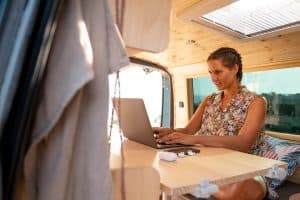Digital Nomad Life Revealed: Essential Tools, Practical Tips & Honest Experiences

Embracing the Freedom to Work from Anywhere
The digital nomad lifestyle is no longer a fringe movement—it’s become a full-fledged cultural shift. Thanks to remote work technology and a growing desire for location independence, more people are choosing to build careers untethered from traditional office settings. But what does this lifestyle really look like? In this guide, we explore the tools, habits, and real-world insights that shape the modern digital nomad experience.
1. Defining the Digital Nomad Lifestyle in 2025
A digital nomad is someone who earns a living by working remotely, using digital tools while traveling or living in different locations. Unlike traditional telecommuters who work from home, nomads continuously shift their base—sometimes monthly or even weekly.
According to a 2024 report by MBO Partners, over 17 million Americans now identify as digital nomads—a 131% increase from pre-pandemic levels. And the trend is global. From Bali to Barcelona, hubs for remote professionals are popping up everywhere.
2. Tech Essentials Every Digital Nomad Needs
🖥️ Smart Gear for Smarter Workflows
To thrive on the move, digital nomads rely on lightweight, durable, and high-performance tech gear:
-
Ultra-light laptops like the MacBook Air M2 or Dell XPS 13 for portability and battery life.
-
Portable power banks (10,000–20,000 mAh) and fast-charging cables.
-
Noise-canceling headphones such as the Sony WH-1000XM5 for productivity in noisy cafés.
-
Universal power adapters that support multiple plug types and voltage ranges.
📶 Staying Connected Globally
Reliable internet access is non-negotiable. Nomads typically use:
-
eSIM-compatible phones with global data plans (e.g., Airalo, Holafly).
-
Mobile Wi-Fi hotspots (MiFi) for backup connections.
-
VPNs like NordVPN or ExpressVPN to secure public network use and access region-locked content.
💡 Pro tip: Always run a speed test on accommodation Wi-Fi before booking. Use tools like Speedtest.net to verify upload/download speeds.
3. Building the Perfect Portable Office

🪑 Prioritizing Ergonomics on the Road
Working on the go shouldn’t mean sacrificing your health. Nomads often carry:
-
Laptop stands to maintain screen height at eye level.
-
Bluetooth keyboards and mice to avoid repetitive strain.
-
Foldable chairs or back supports for posture correction in shared spaces.
🎒 Minimalism Meets Functionality
When every ounce matters, nomads favor multi-use tools:
-
A tech organizer pouch keeps cords, SD cards, and adapters sorted.
-
2-in-1 laptops or compact tablets reduce bulk while offering flexibility.
-
Packable monitors like the ASUS ZenScreen allow for dual-screen setups.
4. Money Management for the Mobile Worker
💳 Choosing the Right Banks and Cards
To avoid unnecessary fees, digital nomads opt for:
-
Travel credit cards with no foreign transaction fees and global ATM access.
-
Apps like XE or Currency Converter Plus to track exchange rates.
📄 Handling Taxes While Borderless
Tax obligations vary based on residence, income source, and visa type. Some countries offer “digital nomad visas” with specific tax perks. It’s essential to:
-
Consult a cross-border tax expert.
-
Use services like Xolo or TaxScout for EU-specific nomad filing.
-
Understand 183-day rules and tax treaties that could impact your filing status.
📊 Budgeting for Stability
Use apps like YNAB (You Need a Budget) or PocketGuard to monitor spending on flights, coworking, health insurance, and food. Nomads often allocate 10–15% of monthly income for tech maintenance and upgrades.
5. Finding Ideal Places to Live and Work

🏠 Where to Stay
Accommodation styles vary by location and budget:
-
Short-term rentals (e.g., Airbnb, Booking.com) provide independence and comfort.
-
Coliving spaces like Selina, Outsite, and Roam foster community and include coworking areas.
-
Extended-stay hostels or guesthouses are popular in Southeast Asia and Latin America.
💼 Best Places to Work
Not all cafés are work-friendly. Look for:
-
Coworking spaces with fast internet and private call booths.
-
Public libraries with quiet zones and Wi-Fi.
-
Community hubs like Impact Hub or Remote Year bases for events and collaboration.
🌍 Nomad hotspot tip: Chiang Mai, Medellín, Lisbon, and Tbilisi consistently rank as top locations due to affordability, weather, and strong nomad network.
6. Staying Connected: Social Life & Relationships
🧑🤝🧑 Making Friends on the Road
While travel is thrilling, it can also get lonely. Nomads often join:
-
Facebook groups, Slack communities (like Nomad List), and Reddit threads.
-
Local meetups via platforms like Meetup.com or Couchsurfing Events.
-
Coworking events or language exchanges to meet locals and fellow nomads.
💬 Keeping in Touch with Home
Routine helps. Try:
-
Weekly video calls or group chats with loved ones.
-
Shared photo albums on Google Photos or Apple iCloud.
-
Virtual game nights or movie watch parties to maintain bonds.
7. Health and Wellness Abroad

🏥 Health Insurance That Works Globally
Nomads often choose plans from:
-
SafetyWing – covers 180+ countries, tailored for remote workers.
-
IMG Global or Allianz Worldwide – more comprehensive, including dental and evacuation.
🧘 Mental and Physical Wellness
Stay active and sane by:
-
Joining local gyms or yoga studios.
-
Practicing mindfulness via apps like Calm or Headspace.
-
Taking digital detox days to prevent burnout.
⏰ Jet lag tip: Melatonin, hydration, and gradual schedule adjustments ease time zone shifts.
8. Legal Considerations & Admin Tips
🛂 Visas and Entry Laws
More than 40 countries now offer remote work visas, including:
-
Portugal’s Digital Nomad Visa
-
Costa Rica’s Rentista Program
-
Estonia’s Remote Work Visa
Always verify:
-
How long you can stay
-
Work permissions under tourist vs. nomad visa
-
Local tax obligations
📦 Managing Mail and Documents
Try services like:
-
Earth Class Mail or Anytime Mailbox to receive physical mail digitally.
-
Notarize.com or DocuSign for legal paperwork on the go.
9. Work-Life Balance: Not as Easy as It Looks
🧭 Structure Your Day for Success
-
Use the Pomodoro Technique to maintain focus.
-
Block work hours in your calendar and stick to them.
-
Plan exploration time after hitting daily work goals.
⛔ Avoiding Burnout
-
Don’t overbook your travel schedule.
-
Create “off days” with no meetings or screen time.
-
Build rituals—like morning journaling or evening walks—for grounding.
10. Learning from Real Nomads
🛑 Common Pitfalls
-
Booking poor Wi-Fi accommodations.
-
Overspending on gear or flights.
-
Losing work-life separation.
✅ What Works
-
Double-check internet before booking.
-
Travel slow—1–3 months per location allows better balance.
-
Build a mobile support system (friends, mentors, community).
11. The Bigger Picture: Ethics, Impact, and the Future
🌱 Traveling Sustainably
-
Favor train travel over flying where possible.
-
Stay in eco-certified lodgings.
-
Use refillable water bottles and local produce to reduce waste.

🫱🏽🫲🏿 Respecting Local Cultures
-
Learn a few phrases in the local language.
-
Avoid “parachute volunteering”—contribute only where requested.
-
Be mindful of your economic impact, especially in fragile communities.
📈 Where Digital Nomadism is Headed
- More governments are embracing nomads as part of post-COVID economic recovery.
- Tech improvements (e.g., Starlink satellite internet) may make even remote islands viable.
- Expect blended lifestyles: part-time nomads, workations, and remote families.
Is Digital Nomad Life Right for You?
The digital nomad lifestyle isn’t just a trend—it’s a transformation. It offers freedom, diversity, and adventure—but also requires planning, discipline, and adaptability. If you’re ready to explore the world while growing your career, try it out for a few weeks first. Gather your tools, research your destinations, and lean into the experience.
✨ You don’t need to go far—you just need to go with intention.





